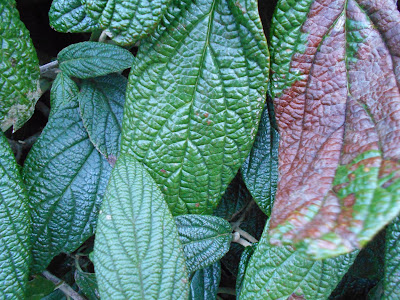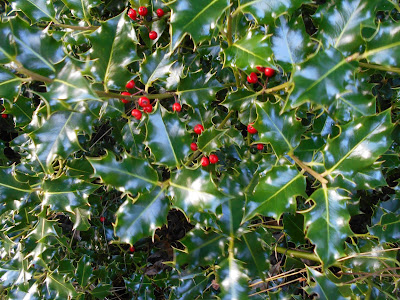With this in mind I set off yesterday for a walk around the western part of the Grange, in Daventry. Burning off calories? You've got to be kidding! I was only strolling, but it was marginally better than being a Couch Potato, Solanum tuberosum, subsp. indolens.
I was quickly rewarded by flowers, having only travelled about two hundred paces from home. A clump of Pot Marigold, Calendula officinalis, had survived winter's icy blasts (What icy blasts?) to create a cheerful sight. It is easy-peasy to grow, brightly coloured and attractive to insects. What's not to like?
 |
Calendula officinalis or Pot Marigold. Christchurch Drive,
Daventry. 28 December, 2018
|
After half a mile I encountered my first fungus. It was, I believe, Velvet Shank, Flammulina velutipes, and was growing in a typical situation on a dying tree stump. I also, three days early, made my first New Year's Resolution for 2019: I must NOT allow myself to be distracted by fungi; they really aren't my thing.
 |
Flammulina velutipes? Probably. Nr. Badby Road West, Daventry.
28 December, 2018
|
I pushed on to reach a road called Grovelands. It is in an area of neat manicured gardens with common or garden (naturally) plants. It was not a promising prospect but I was pleased to find a hedgerow (neatly clipped of course) of a familiar plant. It was the delightful barberry, Berberis darwinii and it was sporting a few flowers. They are of a lovely egg-yolk yellow and are set in evergreen foliage of neat, holly-like leaves.
 |
Berberis darwinii must rank among the finest of all hardy shrubs.
Grovelands, Daventry. 28 December, 2018
|
This shrub, like several other berberis species, is from South America, but its generic name is a Latinised form of the Arabic word berberys. The specific name is of course in honour of Charles Darwin, who discovered it in 1835, but is not given a capital letter. My understanding is using only a lower-case letter for the specific name is not a rule but is a convention invariably followed. If I could choose only one Berberis this would be it.
Trees were proving to be of interest. A handsome eucalyptus, probably Eucalyptus gunnii, caught my eye. We can not always be sure of the species because eucalypts (as they are called) have a marked tendency to hybridise. But whatever it was, it looked lovely, with peeling bark revealing the smooth, unblemished surfaces below.
 |
A Eucalyptus (E. gunnii?) sheds its bark. Staverton Road, Daventry.
28 December, 2018
|
A fern in a lime tree nearby also brought my camera into action, where a specimen of Western Polypody, Polypodium interjectum, was growing in moss as an epiphyte. Of our three species of polypody this is the most likely species to be seen in town. It is more likely to be found on walls of natural stone.
 |
Western Polypody had taken root among moss in a lime tree.
Staverton Road, Daventry. 28 December, 2018
|
Time to turn homewards but a couple of plants made me pause. A geranium, Geranium pyrenaicum, was in flower. It is commonly called the Hedge Crane's-bill but I generally find it on waste or disturbed ground. It is probably an introduction, but it has been known in Britain for at least 350 years and was first recorded in Northamptonshire in 1874.
 |
Geranium pyrenaicum on waste ground near Staverton Road, Daventry.
28 December, 2018
|
It is quite a pretty plant and could feasibly have been introduced for ornamental use in the garden.
Finally a viburnum. Viburnum rhytidophyllum was introduced from China by Ernest Wilson and a fine shrub it is too. At this time of the year the off-white flowers are unspectacular but any flowers are welcome in December. It was in a municipal bed of shrubs.
At their best they make a fine show but for me the handsome foliage is also noteworthy. The leaves are semi-glossy and rugose (wrinkled) and in fact the generic name comes from the Greek rhytis, a wrinkle. (People worried about their advancing years can have a rhytidectomy to expunge these offending features.) Another name for this shrub is the Leatherleaf Viburnum.
I turned on my heel and headed homewards, consoling myself with the knowledge that I'd blown away a few cobwebs even though, three miles or not, my weight essentially remained the same.
Finally a viburnum. Viburnum rhytidophyllum was introduced from China by Ernest Wilson and a fine shrub it is too. At this time of the year the off-white flowers are unspectacular but any flowers are welcome in December. It was in a municipal bed of shrubs.
 |
The flowers of this Leatherleaf Viburnum are not really at their best.
Daventry, 28 December, 2018
|
At their best they make a fine show but for me the handsome foliage is also noteworthy. The leaves are semi-glossy and rugose (wrinkled) and in fact the generic name comes from the Greek rhytis, a wrinkle. (People worried about their advancing years can have a rhytidectomy to expunge these offending features.) Another name for this shrub is the Leatherleaf Viburnum.
 |
I regard the handsome foliage of Viburnum rhytidophyllum as an
important feature.
|
I turned on my heel and headed homewards, consoling myself with the knowledge that I'd blown away a few cobwebs even though, three miles or not, my weight essentially remained the same.






































